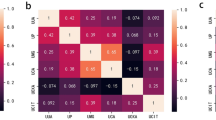Abstract
Urinary cytological examination was performed on 375 patients suffering from urolithiasis at the Department of Urology, University School of Medical Sciences, Bydgoszcz between 01.01.1991 and 31.12.1992. 189 were female(mean age: 47.5 years), 186 were male (mean age: 53.5 years). We found dysplastic cells in urinary sediments in 25.3% of patients before therapy and in 5.3% of patients after conservative or traditional operation and interventional therapy (ESWL, PCNL). Degenerated cells were found in 72%of patients before therapy and in 30.4% after therapy only. In our group neoplasmatical cells were not found. Inflammatory background was found in 44.5% before and in 21.9% after therapy, pyuria in 19.7% and 0.8%respectively. In urinary sediments we found concrements in 24% of patients before and 7.7% after therapy. However, 20 (51.3%) of 39 patients after interventional therapy (ESWL, PCNL) had concrements in urinary sediments. In conclusion, no abnormality was seen in 85.1% before therapy and in 31.2% after therapy. The significance of cytological examination in management of calculous diseases was discussed.
Similar content being viewed by others
References
American Urological Association: Report of American Urological Association ad hoc committee to study the safety and clinical efficacy of current technology of percutaneous lithotripsy and non-invasive lithotrypsy. Baltimore, Maryland: American Urological Association, 1985.
Beyer-Boon ME, Cnypers LHRJ, de Voogt HJ, Brussce JAM. Cytological changes due to urinary calculi: A consideration of the relationship between calculi and the development of urothelial carcinoma. Br J Urol 1978; 50: 81.
Borówka A. ESWL-nowa metoda leczenia kamicy górnych dróg moczowych. Urologia 89. Oddz. Warszawski P.T.U., 1990.
Gajda M, Tyloch F, Tyloch J, Skok Z, Spychalska T, Łapuć A, Sujkowksa R. Evaluation of renal function in industrial workers, based on cytologic examination of urine sediments. Med Prac 1993; 44: 29.
Gajda M, Tyloch F, Tyloch J, Skok Z, Sujkowska R. The role of the esoinophilic granulocytes in urine sediment in patients treated because of BPH. Urol Pol 1995; 48: 227.
Helpap B. Pathologie der ableitenden Harnwege und Prostata. Springer-Verlag, 1989.
Highman W, Wilson E. Urine cytology in patients with calculi. J Clin Pathol 1982; 35: 350.
Hoppe E, Kunz B. Diagnostische Problematik der Urinzytologie nach Urographie. GBK. Fortbildung aktuell 1992; 60/61: 39.
James W, Eagon J. Urinary tract cytology. In: Hill GS, editor. Uropathology, 1989.
Jonitz H, Heinz A. Bakterielle Besiedlung von Hamsteinen bei negativer Urinbakteriologie. Akt Urol 1987; 18: 28.
Klocke K, Winter P, Schoeneich G. Zur Notwendigkeit der Metaphylaxe von Nierensteinbildnern im Zeitalter der extrakorporalen Stoßwellenbehandlung. Urologe B 1993; 33: 74.
Knapp P, Kulb T, Lingemann J, Newmann D, Mertz J, Mosbaugh P, Stelle R. Extracorporeal shock wave lithotripsyinduced perirenal hematomas. J Urol 1988; 139: 700.
Oka T, Imazu T, Nishimura K, Tsujimura A, Sugao H, Takaha M. Clinical studies on the need of prophylactic antibiotics during extracorporeal shock ware lithotripsy. Hinyokika Kiyo 1993; 39: 791.
Pietrautuono M, Prata SM, Maraone A, Vecchio D. Carcinoma squamocellulare della pelvi renale e calcolosi: descuizione di un caso. Acta Urol Ital 1992; 2: 113.
Pfab R, Kleiber W, Kropp W, Hegemann M, Hartung R. Das endoskopisch sichtbare, jedoch radiologisch nicht erkennbare Restkonkrement. Fortschr Urol Nephrol 1988; 26: 292.
Prajsner A, Szkodny A, Noga A, Szewczyk W, Szkodny G. Combination of PCNL and ESWL in treatment of staghorn calculosis of the kidneys. Urol Pol 1992; 45: 176.
Schneider HJ. Ätiologie und Pathogenese der Urolithiasis. Urologe A 1980; 19: 195.
Sökeland J. Harnsteinleiden. Dt Ärzteblatt 1985; 32: 32.
Schubert GE. Niere und ableitende Harnwege. In: Remmele W, editor. Pathologie, Band 3. Springer-Verlag, 1987.
Takahashi H. Farbatlas der onkologischen Zytologie. Fachbuch-Verlagsgesellschaft mbH, 1987.
Tyloch F, Tyloch J, Gajda M, Korenkiewicz J, Sujkowska R. Evaluation of cytological tests results of urinary sediment in patients with suspected neoplasms of the urinary system, treated in the Urological Department of the Medical Academy in Bydgoszcz. Urol Pol 1992; 45: 128.
De Voogt HJ, Rathert P, Beyer-Boon H. Urinary Cytology. Springer-Verlag, 1977.
Author information
Authors and Affiliations
Rights and permissions
About this article
Cite this article
Gajda, M., Tyloch, J., Tyloch, F. et al. Urine cytology in patients with urinary tract calculosis. Int Urol Nephrol 32, 315–320 (2001). https://doi.org/10.1023/A:1017518825573
Issue Date:
DOI: https://doi.org/10.1023/A:1017518825573



